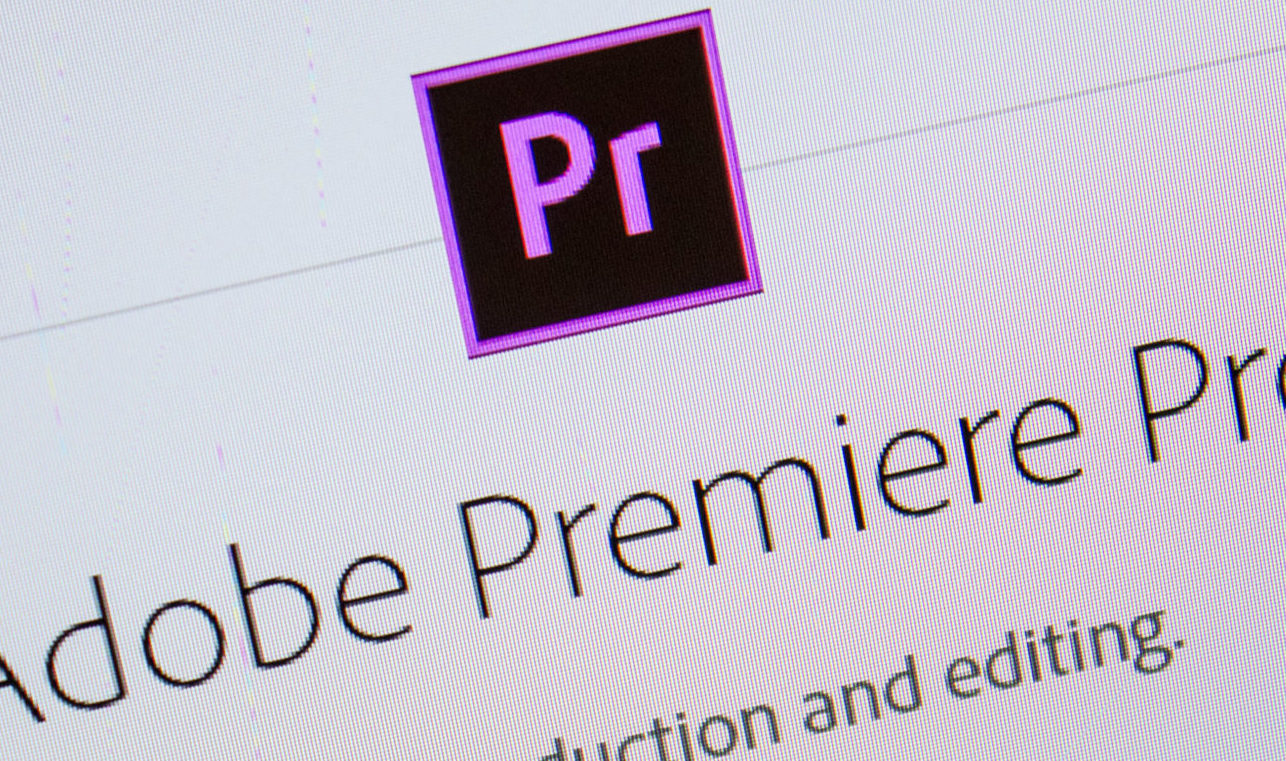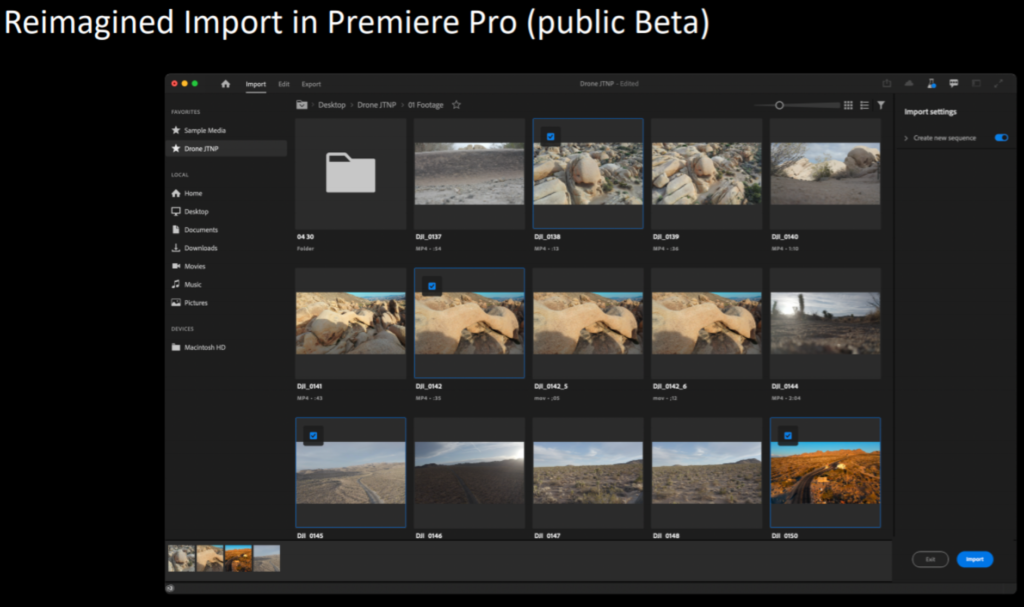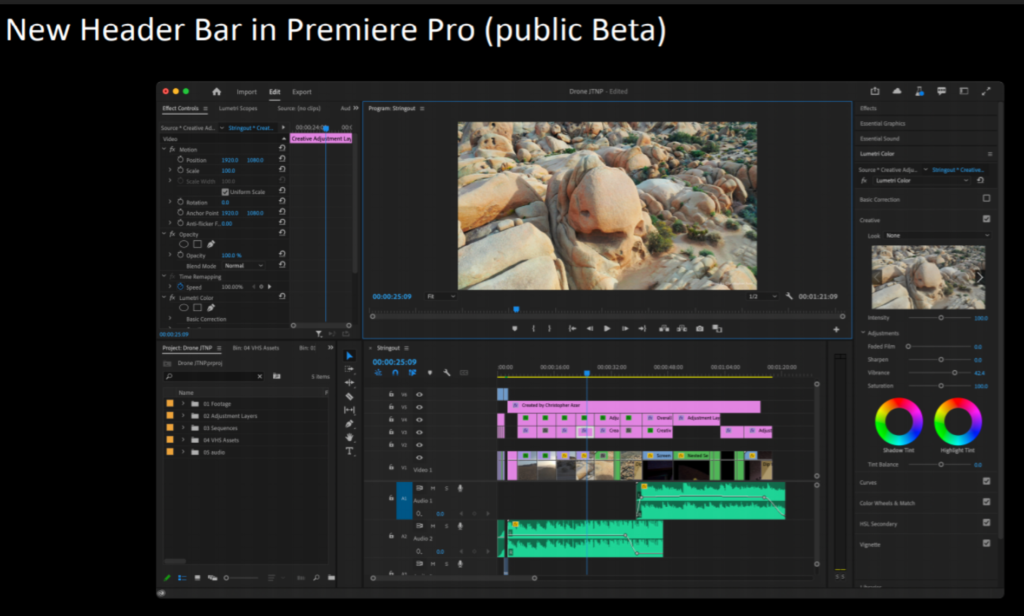
Adobe Unveils ‘Phase One’ of an Enhanced Premiere Pro User Experience
Adobe launched a public beta of what it said is the “first phase” of an enhanced user experience for its Premiere Pro video editing software on June 22.
This is the “first step of a vision to improve the end-to-end user experience for video pros for the next generation,” according to Christopher Azar, Adobe design manager.
“For almost 30 years, Premiere Pro has pushed the envelope of technology to give users features they need to bring their creative visions to life,” he told reporters during a briefing ahead of the launch. “Over that time, we’ve seen video change drastically,” he noted, adding: “There are now more platforms, channels, formats, export options and cameras than ever before. We’ve witnessed a tremendous rise in streaming services, young video creators entertaining us and going viral on TikTok, and a new kind of creator economy where video is at the forefront.”
As all the various types of video content have “evolved, we know that the way our customers use our tools has changed, and we must adapt and innovate alongside the industry,” he said. For Premiere Pro, that meant “radically improving the experience, retaining the depth and power people love and modernizing it for a new generation,” he told reporters.
 The “main goal of our modernization effort is to make Premiere Pro [an] intuitive yet powerful editing tool that helps video creators – the experienced and the new — meet the demands of today,” he explained. “In short, we want to make Premiere Pro easy to learn, more efficient and more enjoyable.”
The “main goal of our modernization effort is to make Premiere Pro [an] intuitive yet powerful editing tool that helps video creators – the experienced and the new — meet the demands of today,” he explained. “In short, we want to make Premiere Pro easy to learn, more efficient and more enjoyable.”
Adobe took into account several of today’s challenges, including: the delicate balance between high production value and tightening deadlines, the need to understand and optimize for several different social platforms, and the need to stand out with a “creative vision and execution to land the brand partnership/influencer deal,” according to the company.
Premiere Pro’s “journey has been a long time coming,” Azar said. After all, “taking a 30-year-old app and modernizing it for new types of video content and users while respecting the needs of traditional post production requires considerable nuance and balance,” he noted.
Also, because Adobe is a “design-led company, we’re expected to make the new experiences beautiful as well as functional,” he said, adding: “In order to get it right, we brought together a cross-functional team from product design, research, engineering [and] customer experience, who all collected and looked at user data. Our design and engineering teams worked in lockstep throughout the entire process and a continual dialogue between the two teams around the functionality and the intention of each iteration made sure we didn’t simplify and streamline things just for the sake of doing so but created new, improved workflows that enhanced the editing process.”
The “most critical” part of the process was Adobe working with customers – “from award-winning editors to the everyday creator – to get their input and feedback all along the way,” he said.
The company realized that “we have to get this right and we absolutely welcome your feedback today,” he told reporters.
That is why Adobe is announcing “phase one of our user interface modernization, which will enter public beta on June 22, so that it can be tested and refined together with our users,” he explained.
The “first phase” of the effort introduces a “refreshed user experience for import and export, as well as a streamlined header bar” that he said “reorganizes workspace and makes it easier to focus on the end-to-end workflow and be more simple and efficient.”
The new header bar was “designed to seamlessly integrate the core phases in the editing process: Import, Edit, and Export,” Adobe said in a blog post. A task-specific workspace dropdown menu and the Quick Export option are now accessible directly via the header, and users can quickly link to what is new in the latest build and provide feedback on the beta test with the click of a button, the company noted. The header bar will be a “universal design element across the Creative Cloud applications to support the import/export process and provide more consistency and familiarity as users orient themselves within different tools,” it added.
Meanwhile, the new import mode offers a faster and better way to get started with media that eliminates setup friction in the application, according to Adobe. The new, unified header features unified in and out points across K9 and flagship applications, the company said.
The new import mode is a “streamlined, media-first experience that focuses on what social video creators and editors need to do first,” which is to “access their content quickly and easily,” Adobe said in the blog post. “While the ability to simply import through the finder or media browser is still an option for existing users, we removed the need to read through complex and confusing settings dialogs like New Project and New Sequence,” the company pointed out.
“This produces a clear path for creators to start new projects, while also providing a better workflow for experienced editors by allowing them to import media from multiple file paths, make favorite folders, and functionality we’ll be adding to the public Beta, such as the ability to preview clips from separate essence files stored in camera folder structures,” the company explained.
And the new export mode provides a “more intuitive destination centric export,” according to Adobe.
 “Today’s video creators and editors alike are constantly faced with the challenge of delivering content optimized for multiple social platforms and delivery formats against quick turnaround times,” Adobe said in the blog post. “To do this previously in Premiere Pro was complicated and hard to manage without knowing the preferred specs of any given destination,” the company conceded. “While the majority of Premiere Pro users are often creating content destined for different places, like social media, many aren’t using the social export feature in the app –or even know it’s there to begin with,” Adobe said.
“Today’s video creators and editors alike are constantly faced with the challenge of delivering content optimized for multiple social platforms and delivery formats against quick turnaround times,” Adobe said in the blog post. “To do this previously in Premiere Pro was complicated and hard to manage without knowing the preferred specs of any given destination,” the company conceded. “While the majority of Premiere Pro users are often creating content destined for different places, like social media, many aren’t using the social export feature in the app –or even know it’s there to begin with,” Adobe said.
With that in mind, Adobe “evolved” Premiere Pro’s export experience from a “format-first approach to a destination-first design,” the company said in the blog post.
The new Export Mode “makes it easier to export multiple files to a local drive and streamlines the process of delivering completed videos by focusing on the destination of the content,” Adobe said, adding: “Users can quickly target either a given media format, or the social media platform where they want to publish (e.g. YouTube), use automatic settings to render it, preview it before publishing, and directly upload their video when ready. We’re working on background rendering so users can continue editing while their videos are exporting, and stay in their creative process.” This improved user experience makes it possible to quickly and efficiently export videos to popular social media platforms, without compromising the flexibility and power more experienced users rely on.”
Francis Crossman, a senior product manager on Premiere Pro, provided a demo of the enhanced features to reporters.
“This is just the beginning,” Adobe said in the blog post. “We’re looking holistically at the entire editing experience so that we can build a framework to address the needs of today and anticipate the possibilities of tomorrow,” it noted, adding more is “to come this year.”
